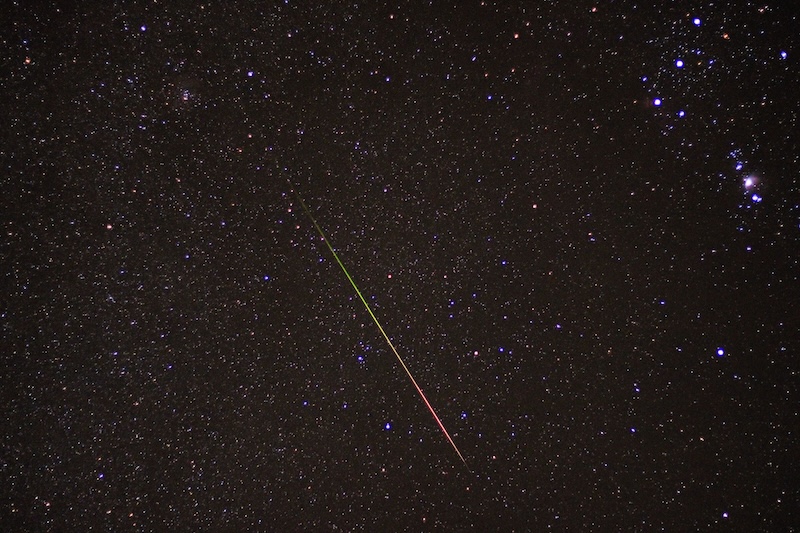Orionid meteor shower 2024: All you need to know

In 2024, the Orionid meteor shower should rain down its greatest number of meteors on the mornings of October 20 and 21. The morning of October 21 might bring the richest display of meteors.
The 2024 lunar calendars are here! Best Christmas gifts in the universe! Check ’em out here.
The Orionid meteor shower
Predicted peak: The peak is predicted** for October 20, 2024, at 18:14 UTC.
When to watch: Watch for Orionid meteors on both the mornings of October 20 and 21, starting after midnight through the wee hours before dawn.
Overall duration of shower: September 26 to November 22.
Radiant: The radiant rises before midnight and is highest in the sky around 2 a.m. See chart below.
Nearest moon phase: The full moon falls at 11:26 UTC on October 17. So, at the Orionids’ peak, the the waning gibbous moon will interfere with the meteor shower.
Expected meteors at peak, under ideal conditions: Under a dark sky with no moon, the Orionids exhibit a maximum of about 10 to 20 meteors per hour.
Note: These fast-moving meteors occasionally leave persistent trains. The Orionids sometimes produce bright fireballs.

Report a fireball (very bright meteor) to the American Meteor Society: it’s fun and easy!
The parent comet of the Orionid meteor shower
From the late, great Don Machholz (1952-2022), who discovered 12 comets …
The Orionid meteors that we observe come from Halley’s Comet. This comet orbits the sun every 76 years or so, and like steam coming from a locomotive, dust particles are expelled from the comet’s nucleus and are left behind in its path. We intercept this path in late October each year. The nucleus of the comet loses between 3 to 10 feet (1 to 3 meters) of material on each passage through the inner solar system. Measuring 5 by 9 miles (8 by 15 kilometers) in size, it can handle eons of orbits around the sun.
The official name for Halley’s Comet is 1P/Halley. It was the first comet to have its return predicted, and Edmond Halley was the one who made that calculation. The comet typically gets bright enough to be easily visible with recorded observations since 240 CE. It is one of only a few comets named not after its discoverer but after the person who calculated its orbit.
Unlike most solar system objects, Halley’s Comet orbits the sun in a retrograde orbit, going around the sun in the opposite direction than we do. Its orbit is also tilted a bit to ours, and it spends most of its time below the plane of our path. Presently, it is at its farthest point from the sun, near the head of the constellation Hydra the Water Snake, too faint to be seen.
Two meteor showers
The Orionids are produced from Halley’s Comet’s particles on its inbound leg. They are moving in one direction, we are moving in nearly the opposite direction, and the combined speeds produce fast-moving meteors. But we also encounter its particles from its outbound leg when it’s leaving the inner solar system. We reach that point in early May. They produce the Eta Aquariids meteor shower. So this comet generates two meteor showers.
Halley’s Comet was last here in 1986 and will return in 2061. But the Orionids never go away, they’re here every October. Go out and see some pieces of this famous comet.

Orionid meteor shower peaks during a waning gibbous moon
As for most meteor showers, the hours between midnight and dawn are best for the Orionids. A waning gibbous will be shining brightly during the peak times of the Orionids in 2024.
The term meteor shower might give you the idea of a rain shower. But few meteor showers resemble showers of rain. And the Orionids aren’t the year’s strongest shower, anyway. Plus they’re not particularly known for storming (producing unexpected, very rich displays). From a dark location you might see 10 to 20 Orionids per hour at their peak. There’s always the element of uncertainty and possible surprise when it comes to meteor showers, though.

Orionids zip through the sky
trains, or ionized gas trails, that last for a few seconds after the meteor itself has gone. Maybe half of the Orionid meteors leave persistent trains.Also, sometimes, an Orionid meteor can be exceptionally bright and break up into fragments.
How will you know if the meteor you see is an Orionid? You’ll know because it’ll come from the shower’s radiant point. See the chart at top.
Orionid meteors radiate from constellation Orion
Meteors in annual showers are named for the point in our sky from which they appear to radiate. The radiant point for the Orionids is in the direction of the famous constellation Orion the Hunter, which you’ll find ascending in the east in the hours after midnight during October. Hence the name Orionids.
You don’t need to know Orion, or be staring toward it, to see the meteors. The meteors often don’t become visible until they are 30 degrees or so from their radiant point. And, remember, they are streaking out from the radiant in all directions. They will appear in all parts of the sky.
But if you do see a meteor – and trace its path backward – you might see that it comes from the club of Orion. And, if so, that meteor will be an Orionid. You might know Orion’s bright, ruddy star Betelgeuse. The radiant is north of Betelgeuse.
Look in different directions
So … in which direction do you look? No particular direction. It’s best to find a wide-open viewing area. Sometimes friends like to watch together, facing different directions. When somebody sees one, that person can call out meteor!
Bottom line: In 2024, the Orionid meteor shower should rain down its greatest number of meteors on the mornings of October 20 and 21. But they’ll be competing with a waning gibbous moon.
**Predicted peak times and dates for meteor showers are from the American Meteor Society. Note that meteor shower peak times can vary.











